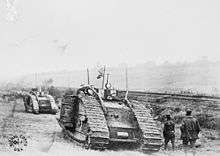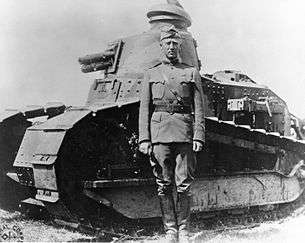Tank Corps of the American Expeditionary Forces
| Tank Corps of the American Expeditionary Forces | |
|---|---|
|
Lieutenant Colonel George Patton, pictured here in France, in the summer of 1918, standing in front of a French Renault tank. | |
| Active | either 22 December 1917[1] or 26 January 1918[2] to 11 November 1918 |
| Country |
|
| Branch |
|
| Part of | the American Expeditionary Force |
| Commanders | |
| Commander | Samuel Rockenbach[3] |
The Tank Corps of the American Expeditionary Forces was the mechanized unit that engaged in tank warfare for the American Expeditionary Force (AEF) on the Western Front during World War I.
Organization
Brigadier General Samuel D. Rockenbach, as the Chief of Tank Corps for the American Expeditionary Forces under Pershing, organized, trained, equipped and then deployed the first American tank units to the Western Front of 1918 Europe.[4] An initial plan for 2,000 light Renault FT tanks and 200 heavy British Mark VI tanks was changed to 20 battalions of 77 light tanks each and 10 battalions of 45 heavy tanks each.[5] A total of eight heavy battalions (the 301st to 308th) and 21 light battalions (the 326th to 346th) were raised, but only four (the 301st, 331st, 344th and 345th) saw combat.[6]
Captain George S. Patton, the first officer assigned to the unit, set up a light tank school at Bourg, France, starting on November 10, 1917.[1][7] In the first half of 1918, the 326th and 327th Tank Battalions were organized at Patton's school, while the 301st Heavy Tank Battalion was raised at Camp Meade, Maryland, USA and transported to the British Tank Schools at Bovington Camp in southern England, for training.[1]
Combat operations

The 326th (under the command of Sereno E. Brett) and 327th Tank Battalions (later renamed the 344th and 345th[8] and organized into the 304th Tank Brigade, commanded by Patton), were the first into combat, beginning with the Battle of St. Mihiel (as part of the US IV Corps) on 12 September 1918, followed by the Meuse-Argonne Offensive (as part of the US V Corps) on 26 September.[6][7][9] Major Brett assumed command of the 304th after Patton was injured during the St. Mihiel Offensive.[10] The small French Renault FT tanks they were equipped with found the going hard and many were lost or ran out of fuel crossing the battlefield – the Germans, forewarned, had largely retreated from the salient.[11]
The 331st Tank Battalion (organized into the 306th Tank Brigade) first saw action in the Meuse-Argonne Offensive (as part of V Corps) in November.[6]
The 301st, equipped with British Mark Vs, suffered large casualties in the Battle of St. Quentin Canal on 29 September[12] as part of the British 4th Tank Brigade, under the control of the Australian Corps.[8][9] Some tanks were hit by shelling before the start line, while others were lost crossing an unreported British minefield. Of the 34 participating tanks, only 10 made rallying.[11]:451 The 301st then seized the village of Brancourt on 8 October, fought in the Battle of the Selle on 18 October, and participated in a night attack on 22–23 October in the vicinity of the Sambre Canal.[8]
Post-war
The AEF Tank Corps was removed after the November 11, 1918 armistice and remaining tank corps personnel transferred to the United States, where the Tank Corps, National Army was disbanded with the National Army in 1920. Headquarters and Headquarters Company (HHC), 304th Tank Brigade, Tank Corps transferred to Camp Meade, Maryland and consolidated with HHC, 305th Tank Brigade on 22 June 1921, reorganized and was redesignated HHC, 1st Tank Group. This organization was reorganized and redesignated HHC, 1st Tank Regiment on 1 September 1929. The 1st Tank Regiment was reorganized and redesignated the 66th Infantry Regiment (Light Tanks) on 25 October 1932.
References
- 1 2 3 Venzon, Anne Cipriano (1995). The United States in the First World War: An Encyclopedia p. 726. Taylor & Francis. ISBN 0-8240-7055-0.
- ↑ George F. Hoffman (1973). "The Demise of the U.S. Tank Corps and Medium Tank Development Program". Military Affairs. 37: 20–25. JSTOR 1986566.
- ↑ Wilson, Dale, p. 19
- ↑ Rockenbach, Samuel (2016). The Rockenbach Report. Silver Spring, Maryland: Dale Street Books. pp. 9–72. ISBN 9781941656365.
- ↑ Wilson, Dale. "The American Expeditionary Forces Tank Corps in World War I: From Creation to Combat" (PDF).
- 1 2 3 Rinaldi, Richard A. (2004). The US Army in World War I – Orders of Battle. Tiger Lily Publications LLC. ISBN 0-9720296-4-8.
- 1 2 Votaw, John; Duncan Anderson (2005). The American Expeditionary Forces in World War I. Osprey Publishing. ISBN 1-84176-622-4.
- 1 2 3 Hoffman, George F (1999). Camp Colt to Desert Storm. University Press of Kentucky. ISBN 0-8131-2130-2.
- 1 2 "U.S. Military History Companion: Army Combat Branches: Armor". answers.com. Retrieved 11 October 2008.
- ↑ Rockenbach, Samuel (2016). The Rockenbach Report. Silver Spring, Maryland: Dale Street Books. p. 48. ISBN 9781941656365.
- 1 2 Campbell, Christy. Band of Brigands. pp. 451–2. ISBN 0-00-721459-6.:452
- ↑ Rockenbach, Samuel (2016). The Rockenbach Report. Silver Spring, Maryland: Dale Street Books. pp. 175–181. ISBN 9781941656365.
